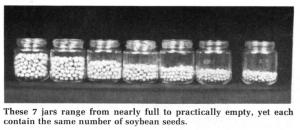1982 - Volume #6, Issue #6, Page #10
[ Sample Stories From This Issue | List of All Stories In This Issue | Print this story
| Read this issue]
New Soybean Sizer Helps Boost Yields
 |
"Because seed size isn't uniform, it's next to impossible to set seed rates correctly. Therefore, yields are usually below what they easily could be," says Roger Peters, farmer from Oak Harbor, Ohio, who's son Dan has patented a new "soybean sizer" that the Peters claim has boosted yields as much as 55% on their own farm.
"Every farmer has had the experience of ending up a field with 10 to 15 extra bushels of seed that he wished were planted, or of running short before finishing when he should have had plenty to spare. We've checked plant populations in local fields and found variations among similar varieties from 58,000 plants per acre to 338,000 plants per acre. We can eliminate these variations with our sizer, and boost yields," says Peters.
The soybean sizer, called the Accu-Bean-Chek, is 10-in. in dia. and about 16 in. tall. It has six layers of precision tooled screens with openings ranging from 19/64 to 14/64 in. in dia., top to bottom. To determine the number of seeds per pound, a sample of seed is poured into the top of the unit and then the unit is gently rocked by hand. This causes the seeds to sift down through the six layers, sorting themselves out to size. Once all the seeds are settled, you count the seeds on each layer and, using charts supplied with the sizer, determine the number of seeds per pound.
Once you have the number of seeds per pound in a particular lot of seed, you take that number to another chart and determine how many pounds per acre must be planted to arrive at a desired plant population. The entire process takes 10 to 15 min.
"Since seed is packed by lots you don't have to check each bag. And, even if the company lists the number of seeds per pound on their bags, our sizer allows you to check their figures and determine how good a job they are doing," explains Peters. "We've found that many of the top farmers and yields contest winners are aware of the soybean seed problem and have found their own way to size seed for correct populations.
"When purchasing certified seed, you should buy a small seeded variety. At equal population, small seed at 3,000/lb. versus larger seed at 2,000/lb. will plant three acres instead of two ù a one-third savings on seed cost per acre. At $15 per bushel for certified seed, that immediately saves you $5.00 for every acre you plant. University tests have shown there is no noticeable decrease in viability for small seed varieties. Farmers can also check their own cleaned bin-run seed. Sizing will prevent overplanting small seed ù which can reduce yield due to lodging, barren stalks, and so forth ù or underplanting larger seeds, which could result in thin stands," says Peters.
The Accu-Bean-Chek soybean sizer, complete with sizer and charts, sells for $189. The Peters also sell corn and soybean charts that let you accurately check plant populations in minutes by counting the number of plants in a short section of row. They sell for $5.95 per chart, or $10 for both.
For more information, contact: FARM SHOW Followup, Accu-Bean-Chek, P.O. Box 218, Oak Harbor, Ohio 43449 (ph 419 898-1210).

Click here to download page story appeared in.

Click here to read entire issue
To read the rest of this story, download this issue below or click here to register with your account number.




